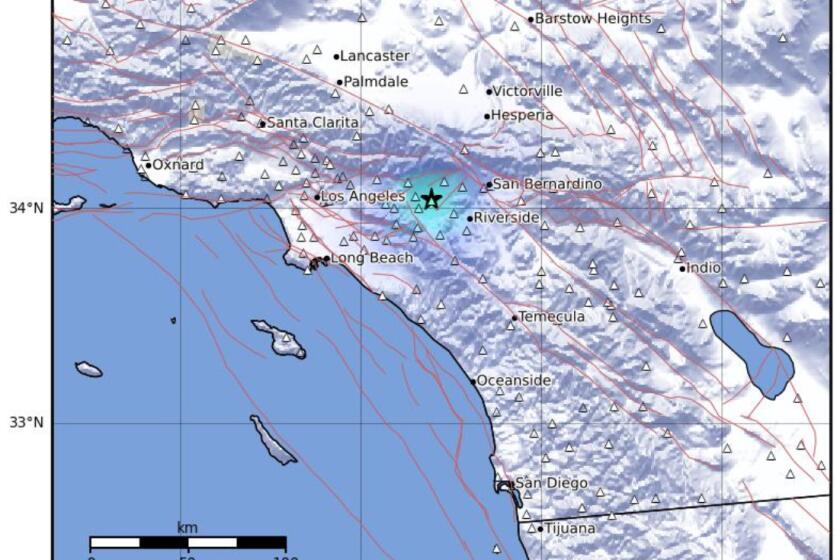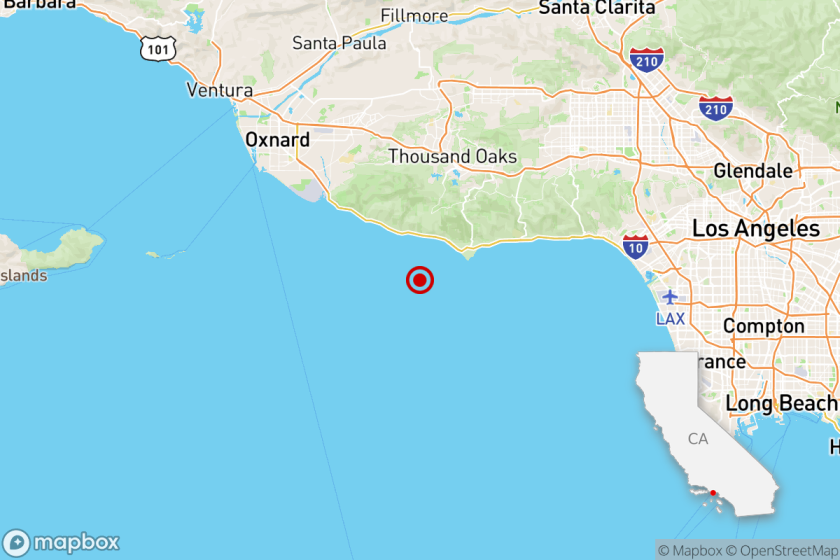Quake Research Shakes Up Usual Thinking on Safest Construction
RICHMOND, Calif.--California’s building industry, lulled into complacency by the relative quiet along the fault lines that crisscross the state, will be rudely awakened to the need for stronger structures when the inevitable “big one” strikes, a top earthquake engineer warned.
There are, of course, ominous reminders of the powerful forces at work beneath the surface--mild quakes of about 4.4 magnitude rumbled through both Northern and Southern California during April’s Earthquake Preparedness Month.
Yet, with the exception of modern skyscrapers, which are designed to sway but not break in a major tremor, few innovative techniques for dissipating the destructive jolts of earthquakes are being used in the construction industry.
In many cases, just a simple and inexpensive bracing system could be used within a building to foil the force of an earthquake, preventing damage and saving lives. Unfortunately, even these devices are largely ignored in construction and renovation projects.
A “base isolation” system for small- and medium-rise buildings is also available and consists of placing the structure on a series of barrel-shaped steel and rubber “sandwiches” that isolate the building from the horizontal motion of the earth. Only a few builders, however, have actually used the technique in this country.
“There’s no doubt we’ll have a big one and when we do we’ll have a disaster,” said Vitelmo Bertero, director of the Earthquake Engineering Research Center. “This is what really worries me. We have to wake up. The building industry has to wake up.”
Employs ‘Shaking Table’
The research center, operated by the University of California, is the site of the nation’s largest and most sophisticated “shaking table,” a 50-ton concrete slab that can simulate earthquakes for testing practically any type of structure--buildings, dams, bridges, even sections of pipeline.
It would seem that private industry would heavily support research that would lead to safer and stronger houses and buildings, especially in earthquake-prone regions, but Bertero said this has not occurred.
Funding for the shake-table experiments has come mostly from the university and National Science Foundation.
In contrast, he said, Japan, which has been in a 20-year cycle of severe earthquakes, has moved rapidly ahead in the field because the construction trade funds the engineering research and is using the results in practical building applications.
“Japan has made tremendous progress,” Bertero said. “We’re way behind in terms of application. If we don’t change, future construction power in seismic regions will be in the hands of the Japanese. Even in this country we have been losing markets and we’ll lose all the markets. It’s unbelievable.”
Scientists, including Bruce Bolt, director of the University of California’s seismographic laboratory, said there’s a 50-50 chance a major shake similar to the great San Francisco earthquake of April 18, 1906, will hit along the San Andreas or Hayward faults in Northern California within 30 years.
In Southern California, the chances are similar for a big quake along either the same San Andreas or the San Jacinto fault.
At the shaking table, a control center can simulate any recent earthquake from recorded data and test how different buildings, materials or earthquake devices would have withstood the event. Bertero said a product that shows great promise in buffering vibrations is something known as ADAS--Added Damping and Stiffness.
Reliable Absorption System
ADAS structural elements are “the best energy dissipation system we have tested,” Bertero said of the bracing system. “It’s very reliable, inexpensive and has a good future both for retrofitting buildings and for new construction.”
The ADAS elements, he said, provide increased damping, which lessens shaking, and greater overall stiffness to a structure that helps lessen earthquake damage.
“Japan has other systems more sophisticated using hydraulic jacks and based on friction, but they’re tremendously expensive, which is the drawback,” Bertero said. “You need economy and reliability.”
UC engineering professor James Kelly, who has led the development of the base isolation system at the Richmond center, agrees with Bertero about the Japanese dominance in the application of seismic devices.
“They are extremely active and there are perhaps 20 buildings on isolation systems in Japan,” Kelly said. “The Japanese started later but have gone much farther with it.”
“Probably the real reason is the difference in attitude in Japan. Here, construction companies work at minimizing costs first. In Japan, they’re willing to pay 5% to 10% more” to build with devices that would reduce earthquake damage, he said.
Rancho Cucamonga Center
In the United States, Kelly said, the first building to use base isolation was the $30-million Foothill Communities Law and Justice Center in Rancho Cucamonga, Calif., a 265,000-square-foot complex sitting on 98 rubber bearings 30 inches in diameter and 15 inches high.
The structure, located in prime earthquake country, got its first real test in October, 1985, when a small earthquake shook the building, equipped from top to bottom with instruments for measuring stresses and strains.
“The response of the building was very, very favorable,” Kelly said. “It was exactly what we expected.”
Energy amplification on the roof of the five-story complex, he said, was actually less than what the quake measured on the foundation below the isolators. A similar building nearby, also with instrumentation but conventionally built, measured an energy acceleration on the roof five times greater than that of the foundation, he said.
The significant difference, he said, was actually overstating the case since small quakes tend to amplify the signals more than would an intense quake. Damage also absorbs energy, he said, so if there is no damage in a small quake, there would be more energy amplification.
Another large building using base isolation is the Evans and Sutherland computer manufacturing plant in Salt Lake City. Under construction is the County Fire Command and Control Facility in Los Angeles and in the planning stages is a University of Southern California hospital.
Application Limited
Base isolation is only effective for small- or medium-sized buildings under seven stories and when used on a firm surface. Kelly is also developing low-cost isolation systems for residential structures, including masonry, brick and adobe homes.
“There is no question that in the next 10 or 20 years we’ll see a fairly large number of buildings using base isolation, but it will never be more than a small percentage overall,” Kelly said. He said the best opportunity for the method is in rehabilitating existing masonry buildings, for example, that are of architectural or historical value.
“Conventional rehabilitation with earthquake protection generally requires a change in the fabric of the building. Isolation only affects the foundation level and it’s much cheaper.”
He said California’s earthquake building codes, although stringent, have as their basis the protection of life rather than minimizing of structural damage.
“If designed to code, a building can have serious damage and even be rendered completely uninhabitable, but still satisfy the life safety requirements. In many cases, what is needed is more damage control, which isolation can provide. It will reduce severe damage and in the long run, the costs will be lower.”
Great Deal Known
Scientists have learned a lot about which structures stand and which ones collapse from studying recent powerful earthquakes--including the devastating Armenian temblor last December that killed at least 25,000 and injured 19,000, leaving 500,000 homeless and damage estimated at over $16 billion.
Unreinforced structures collapsed, heavy damage occurred to buildings on fill or sandy soil, and buckling occurred in structures with poor bracing and weak joints.
Bertero said that in San Francisco, although many tall buildings are on fill, they are probably constructed well enough to withstand a strong quake. The downtown danger, he said, would be from falling objects from decorative facades and shards of glass that would hit the narrow streets like deadly missiles.
“The real problem in San Francisco and most of our cities are those buildings four to 10 stories tall, the condominiums, those built just for business and real estate transactions, these are the ones that collapse,” Bertero said.
More to Read
Sign up for Essential California
The most important California stories and recommendations in your inbox every morning.
You may occasionally receive promotional content from the Los Angeles Times.










